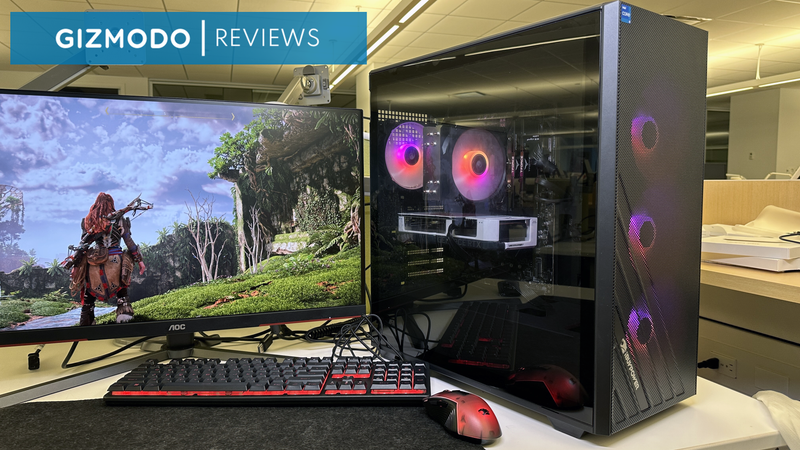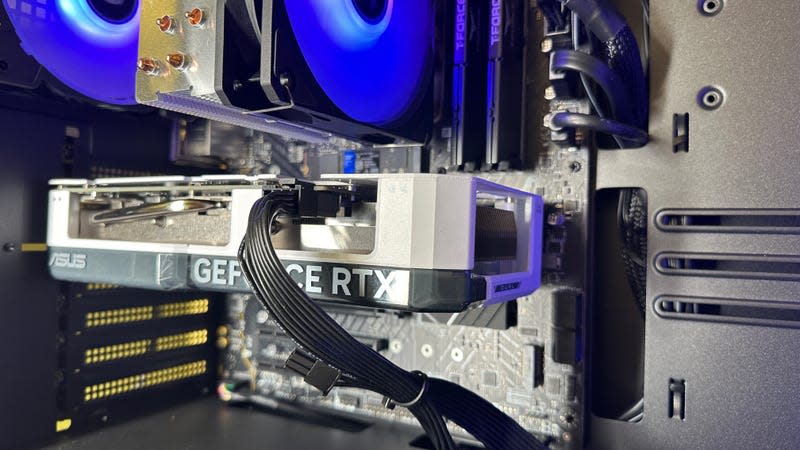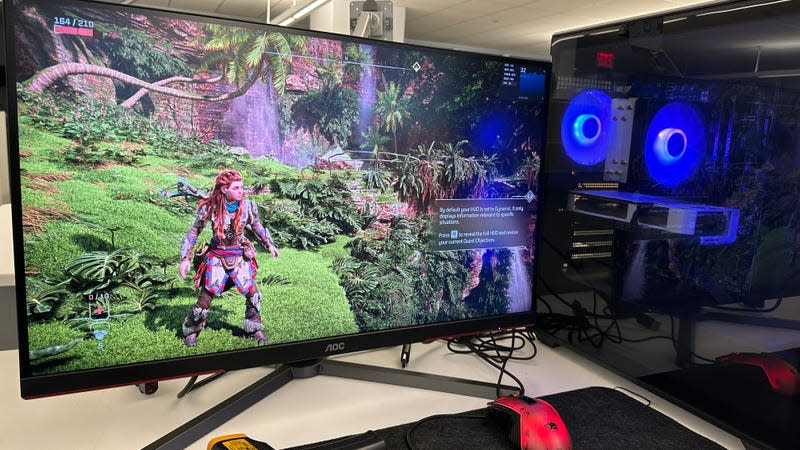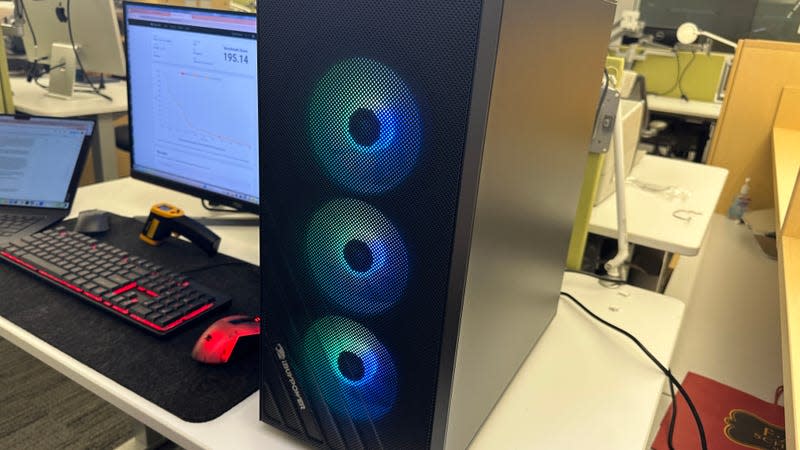iBuyPower Scale RDY PC Review: The Minimum You Need for Great Gaming

If Conan the Barbarian was a desktop gaming PC enthusiast, and you asked him what is best in life, his answer would probably be the standard “crush those framerates… see the pixels driven before you… hear the lamentations of your CPU fan,” or something of that nature. He’d want the biggest desktop, the biggest GPU, the most expensive CPU, water cooling, the works. He’d build it all himself, of course. It would cost Conan a pretty penny, but that’s why he can go around stealing jewels from snake cults on a lark. I’d argue that the rest of us are better served with something a little more mundane. In that way, the iBuyPower Scale RDY represents what is pretty much the minimum entry point for playing PC games on high settings and stable framerates.
Because what Conan wouldn’t realize underneath all that muscle and bulk, is you don’t need that much power to play your games. With a lot less juice, a little compromise, and a lot less money, you can get away with a gaming rig that still looks the part and plays your games on high settings. It still feels a bit of a shame that you need to spend upwards of $1,000 to achieve what’s ultimately a mid-range rig.
iBuyPower’s $1,150 MSRP RDY Scale 003 gaming PC isn’t the cheapest pre-built unit out there, but it does offer a lot of avenues for future upgrades in a rather pretty case. It’s a mid-sized tower with a nice spread of RGB glowing fans contained within, but if you were hoping for something more than a simple CPU fan for cooling and a big, white Nvidia graphics card, there’s not much else to look at. Sometimes simple is best, but there’s a lot of negative space inside that feels like it’s screaming for a bigger PC than the company provides. Compare that to a pre-built Alienware Aurora R16, which is a bit more manicured but is held back by the proprietary motherboard.
The tower comes with an Intel Core i5-14400F CPU, an Nvidia GeForce RTX 4060 with 8 GB of VRAM, and 16 GB of DDR5 RAM on two sticks. All together, it offers you enough room to beef up your PC in the future, and we should be clear that upgrading is the name of the game here. You’ll eventually want more memory or a better CPU or GPU. However, you might be constrained by the 600W PSU at 80 Plus Gold certified, which is not going to be enough for something like today’s RTX 4080s, 4090s, and even some 4070s. Inevitably, you’ll need even more power to hit the high-water mark of more expensive graphics cards. It’s a weak link in the chain of what would otherwise be a perfect starting point for the nascent PC gamer.
It doesn’t help that extra manufacturer bloatware comes stock thanks to the MSI-brand motherboard, plus a built-in tab that does nothing but link you to iBuyPower’s website to try and get you to write reviews or join the company’s Reddit or Discord to win a few prizes. On top of those annoyances, my unit came with Windows 11 Home Edition which throws in a whole slew of annoying settings and notifications for first-time users.
Despite all that, the RDY Scale does enough to justify its $1,150 price point. Just don’t expect it to carry you to the highest possible settings for every new release. You might still want to look at more specialized, bespoke and absolutely stuffed pre-fabs like the Alienware Aurora R16, but here you can guarantee you’ll have enough room to branch out however you like.
iBuyPower RDY Scale Build Quality
Looks Good, But I Don’t Trust Pressure-Fit Cases

The reason you buy a pre-fab PC is that it doesn’t require any time or esoteric knowledge to put together. The least a company can do is make its actual case look good. You know what, the IBP Scale ARGB Case looks good, if a little too standard. The three main fans glow with a nice soft light behind a sturdy metal grate with clean wave-like perforations running through the aluminum. The airflow moves silently from back to front thanks to the glowing RGB fans. Inside, you won’t see any pipes or covers to mask the hardware inside, but that’s perfectly fine at this scale. All of the cable management has been done for you, and it’s tucked away behind the motherboard.
All the internals are perfectly accessible even when you don’t have tools nearby, as the Scale ARGB Gaming Case doesn’t need a screwdriver to open the main glass panel. Instead, it’s pressure-fitted with a few nubs running along the top. You just need to get your fingers behind the glass plate, and with a little effort it comes off with a “pop.” I shook the tower a fair bit while unboxing, and I gave it a few more quakes for good measure, and the glass window seems pretty well fixed in place. I am rather concerned that those nubs are a major point of failure should either get damaged or come off, but I can’t say I had any issues with my case even after removing and replacing the panel multiple times over the course of a week. The other side panel is connected in the same way, though the right side of it is completely bare. Most cases want to hang out on the right side of your desk, but iBuyPower’s entry-level PC looks like some dull brushed steel shelving unit if you look at its starboard flank.
You might notice there’s a lot of breathing room inside the case. The tower is 18.5 inches long, a little over 19 inches tall, and 8.6 inches deep. Compared to your average RTX 4080 or 4090, the RTX 4060 is scaled to a much more comfortable size that doesn’t even measure the length of the motherboard. The RDY Scale 003 looks a little bit like a small child trying to dress in a suit that’s a bit too big for him.
As I mentioned, the tower is dead silent even under stress. It also keeps very cool under duress. The CPU itself read a high of 43 degrees celsius (109 degrees Fahrenheit). I couldn’t measure a single part of the case inside or out that rose higher than 96 degrees Fahrenheit reading it with an external laser thermometer. The attached heatsink and fan do enough to keep the heat down. The CPU itself kept to a healthy temperature during stress.
The keyboard and mouse that come with the iBuyPower case sure do look good from the outside thanks to all the glowy bits, but make no mistake both are very cheap, starter controls that are only enough for tiding you over until you can get your hands on something with even a modicum more oomph. Both the keyboard and mouse on the Chimera KM7 pack feel plastic-y and squishy. The RGB Gaming Keyboard especially leaves a lot to be desired. The font is ugly, and they couldn’t even spring for an LED to let you know if your caps lock is turned on. It’s not a mechanical keyboard, and I wasn’t expecting much but it still left me feeling like I had reached into the Best Buy bargain bin and still made out with a bad deal.
The motherboard itself is the MSI PRO B760-VC with the LGA1700 socket. If we’re soon to leave the socket cycle and move on to something else, at the very least you have an obvious upgrade path in a few years when the Intel Core i7s or the i9s start getting a bit cheaper. You don’t have to worry too much about all the talk of AI and the laptop-based Intel Core Ultra CPUs. For the most part, the Ultra 7 and Ultra 9 have performance at or below current i7s and i9 chips, respectively. Intel has said it will eventually bring the Ultra chips to the LGA1851 socket-compatible PCs, but that’s yet to come about this year.
iBuyPower RDY Scale Performance
Plays Games at Respectable Framerates Even at 4K, Though With DLSS

Benchmarks on the RDY Scale were about what I expect from a rig holding an i5-14400F and an RTX 4060. It does the job well but won’t blow your socks off by any stretch of the imagination.
Benchmarks proved the RDY Scale was up to the task of handling its hardware. The i5-14400F is one of the lower-end chips Intel’s put out, with a better base clock speed compared to the previous generation. The chip boasts a boost speed of 4.7 GHz, and the “F” in the name refers to it lacking any real graphical capability, which is fine because that’s all being handled by the dedicated GPU. Geekbench and Cinebench stress tests show it’s an ok mid-range chip, though it still sits at or below the averages for an AMD Ryzen 5 7600. It’s not exactly crushing anything either with our Blender benchmarks where we ask the PC to render a single scene.
I ran my games on a 4K monitor that can push 120 Hz refresh rates, and I found I didn’t need to sacrifice visuals much at all. Muddling with the settings on Cyberpunk 2077 I managed to get around 60 FPS on high and 4K resolution during normal gameplay with a little bump from DLSS. Ditto for Baldur’s Gate III, which could hit 60 FPS with DLSS in performance settings in interiors, in the outdoors of Act 1, and in the crowded city of Act 3.
It’s what I’ve come to expect from an RTX 4060 with 8 GB of VRAM. Today’s games are far more accessible to lower-end specs thanks to AI upscaling software you can find in pretty much all major titles in some shape or form. So when you stick the whole rig into a benchmark like 3DMark, you really shouldn’t expect to see sparks. It’s a mid-range tower, and it feels it.
Still, the setup has a definitive “just enough” quality. On some more recent titles, you may have to compromise a bit more. I could squeak out just under 60 FPS in some areas of Horizon: Zero Dawn but in others it dipped closer to 30. That was with DLSS set to performance, so for a steady 60, you may need to lighten the load on certain grass, sky, or water textures. In a game like Suicide Squad: Kill the Justice League, I could eke out about 60 FPS in some of the opening areas on high settings without ray tracing. In other sections with a bigger draw distance, it was dipping closer to 40, though it never went too far into unplayable framerates.
Like many of PCs in this price range, you might have to be patient with your machine. Give it the benefit of the doubt, but inevitably be prepared to soften your expectations just a little bit.
I Wish ‘Budget’ Pre-Built PCs Could Actually Support a Budget

Take a gander on Google and you’ll find a lot of PCs with very similar specs sitting around the same price point. iBuyPower’s RDY Scale is currently priced at $1,050 on their website, which is about what you’ll find elsewhere. It’s well-built and sturdy, and it looks the part of a gaming PC. Taken all together, the parts themselves individually would actually run close to $1,000 already (though that’s without bargain hunting), so in reality you’re spending around $50 to $100 on the labor for somebody else to put it all together.
It’s a fair deal, especially since you can expect great gaming even at 4K. There’s room to grow over time, and you won’t have to do much to expand the possibilities of your PC (though you should test the PSU’s capabilities before upgrading or overclocking too hard). I want to shout from the rooftops that you don’t need a spectacular desktop to play PC games at great to fair settings, but I still wish there was some modern nirvana of budget desktops. Cards and CPUs today cost more than they ever have, and “mid-range” today is yesterday’s top-tier.
Want more of Gizmodo’s consumer electronics picks? Check out our guides to the best phones, best laptops, best TVs, and best headphones. If you want to learn about the next big thing, see our guide to everything we know about the iPhone 16.
Update 04/29/24 at 6:19 p.m. ET: This post was updated to correct the nature of the CPU cooler on the RDY Scale, which misidentified the IBP AW4 240MM Cooler.

